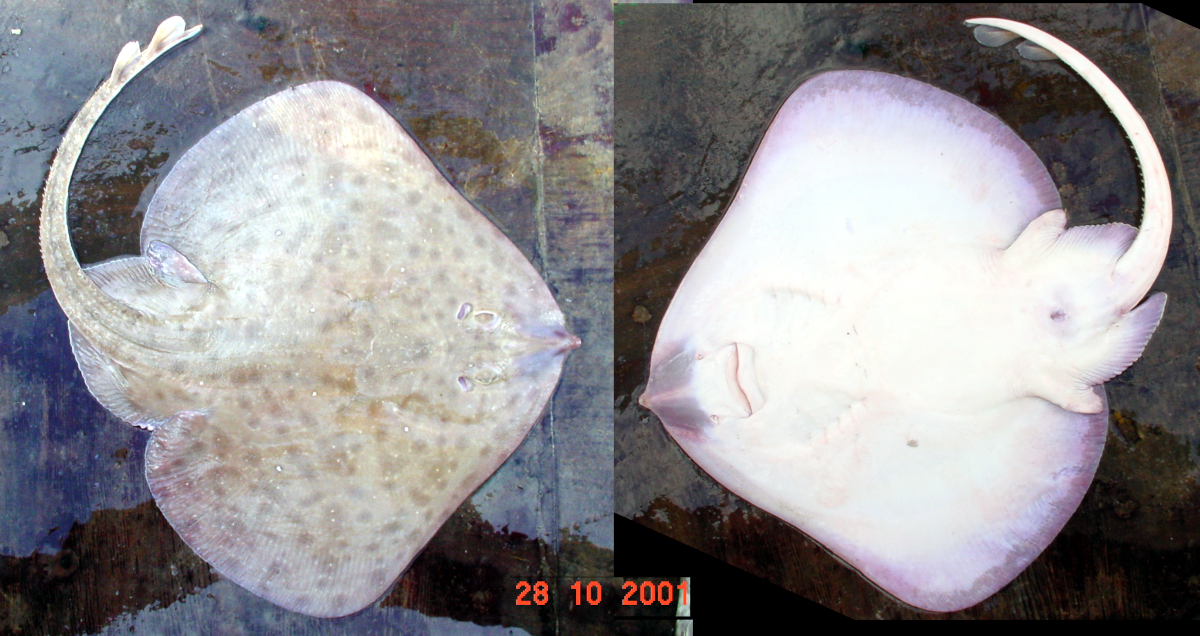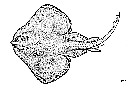Leucoraja circularis
(Couch, 1838)
Sandy ray
Classification: Elasmobranchii Rajiformes Rajidae
Reference of the original description
A Cornish fauna, being a compendium of the natural history of the county. Part I. Vertebrate, crustacean, and a portion of the Radiate animals. Cornish Fauna
A Cornish fauna, being a compendium of the natural history of the county. Part I. Vertebrate, crustacean, and a portion of the Radiate animals. Cornish Fauna
Synonyms / new combinations and misspellings
Amblyraja circularis, Raia circularis, Raja circularis, Raja falsavela, Raja falsavela intermedia, Raja falsavela maggiore, Raja (Leucoraja) circularis
Amblyraja circularis, Raia circularis, Raja circularis, Raja falsavela, Raja falsavela intermedia, Raja falsavela maggiore, Raja (Leucoraja) circularis
Types
Leucoraja circularis
XXXX: No types known;
Raja falsavela
Holotype: ANSP: 406 (missing, old: Bonaparte 222);
Raja falsavela intermedia
XXXX: No types known;
Raja falsavela maggiore
XXXX: No types known;
Leucoraja circularis
XXXX: No types known;
Raja falsavela
Holotype: ANSP: 406 (missing, old: Bonaparte 222);
Raja falsavela intermedia
XXXX: No types known;
Raja falsavela maggiore
XXXX: No types known;
Description :
Citation: Leucoraja circularis (Couch, 1838): In: Database of modern sharks, rays and chimaeras, www.shark-references.com, World Wide Web electronic publication, Version 12/2025
Please send your images of "Leucoraja circularis" to info@shark-references.com

Leucoraja circularis (Couch, 1838), DW: 45 cm, TL: 93 cm, on the bottom (about 200 m of depth) between Capraia and Gorgona islands in the North of Tyrrhenian Sea, Mediterranean © Fabrizio Serena

Leucoraja circularis (Couch, 1838), DW: 45 cm, TL: 93 cm, on the bottom (about 200 m of depth) between Capraia and Gorgona islands in the North of Tyrrhenian Sea, Mediterranean © Fabrizio Serena
Common names
 Sandroche,
Sandroche,  Sandrochen,
Sandrochen,  Raya circular,
Raya circular,  Raya falsa vela,
Raya falsa vela,  Raie circulaire,
Raie circulaire,  Raie ronde,
Raie ronde,  Raie ronde circulaire,
Raie ronde circulaire,  Cuckoo ray,
Cuckoo ray,  Sandy ray,
Sandy ray,  Sandy skate,
Sandy skate,  Razza rotonda,
Razza rotonda,  Raia-de-São-Pedro
Raia-de-São-Pedro
 Sandroche,
Sandroche,  Sandrochen,
Sandrochen,  Raya circular,
Raya circular,  Raya falsa vela,
Raya falsa vela,  Raie circulaire,
Raie circulaire,  Raie ronde,
Raie ronde,  Raie ronde circulaire,
Raie ronde circulaire,  Cuckoo ray,
Cuckoo ray,  Sandy ray,
Sandy ray,  Sandy skate,
Sandy skate,  Razza rotonda,
Razza rotonda,  Raia-de-São-Pedro
Raia-de-São-Pedro
Short Description
Snout short, its tip somewhat pronounced; upper surface entirely spinulose, about 8 thorns generally in a complete row around inner margin of eye and a triangle of thorns on nape or shoulder region; underside with prickles only on snout, between gill-slits, along abdomen, and at anterior margins of disc; tail only slightly longer than body; upper surface reddish-brown to dark brown with 4-6 creamy spots on each wing, underside white [7182].
Snout short, its tip somewhat pronounced; upper surface entirely spinulose, about 8 thorns generally in a complete row around inner margin of eye and a triangle of thorns on nape or shoulder region; underside with prickles only on snout, between gill-slits, along abdomen, and at anterior margins of disc; tail only slightly longer than body; upper surface reddish-brown to dark brown with 4-6 creamy spots on each wing, underside white [7182].
Distribution
Eastern Atlantic: Iceland [20065], southern Norway, Skagerrak and Morocco, including western Mediterranean. Records as far south to Mauritania and Senegal could not be verified due to lacking descriptions and specimens; most are probably misidentifications of Leucoraja leucosticta. Source: www.gbif.org
Eastern Atlantic: Iceland [20065], southern Norway, Skagerrak and Morocco, including western Mediterranean. Records as far south to Mauritania and Senegal could not be verified due to lacking descriptions and specimens; most are probably misidentifications of Leucoraja leucosticta. Source: www.gbif.org
Human uses
fisheries: minor commercial; price category: medium; price reliability: reliable: based on ex-vessel price for this species
fisheries: minor commercial; price category: medium; price reliability: reliable: based on ex-vessel price for this species
Biology
Oviparous, paired eggs are laid. Embryos feed solely on yolk [733]. With no definite egg laying period [7182]. Distinct pairing with embrace. Young may tend to follow large objects, such as their mother [17086].
Oviparous, paired eggs are laid. Embryos feed solely on yolk [733]. With no definite egg laying period [7182]. Distinct pairing with embrace. Young may tend to follow large objects, such as their mother [17086].
Remarks
shark-references Species-ID=3487;
shark-references Species-ID=3487;
Parasites (arranged by Jürgen Pollerspöck)
Monogenea
Cestoda
Monogenea
- Calicotyle kroyeri Diesing, 1850 [17150]
Cestoda
- Acanthobothrium dujardinii Van Beneden, 1849 [16101]
- Acanthobothrium sp. [16448]
- Ditrachybothridium macrocephalum Rees, 1959 [16380] [16430] [19536]
- Echeneibothrium elongatum Williams, 1966 [16953]
- Grillotia erinaceus (Van Beneden, 1858) [16112]
- Phyllobothrium lactuca Van Beneden, 1850 [16443]
- Pseudanthobothrium aegyptiacus (Hassan, 1982) [16322]

















